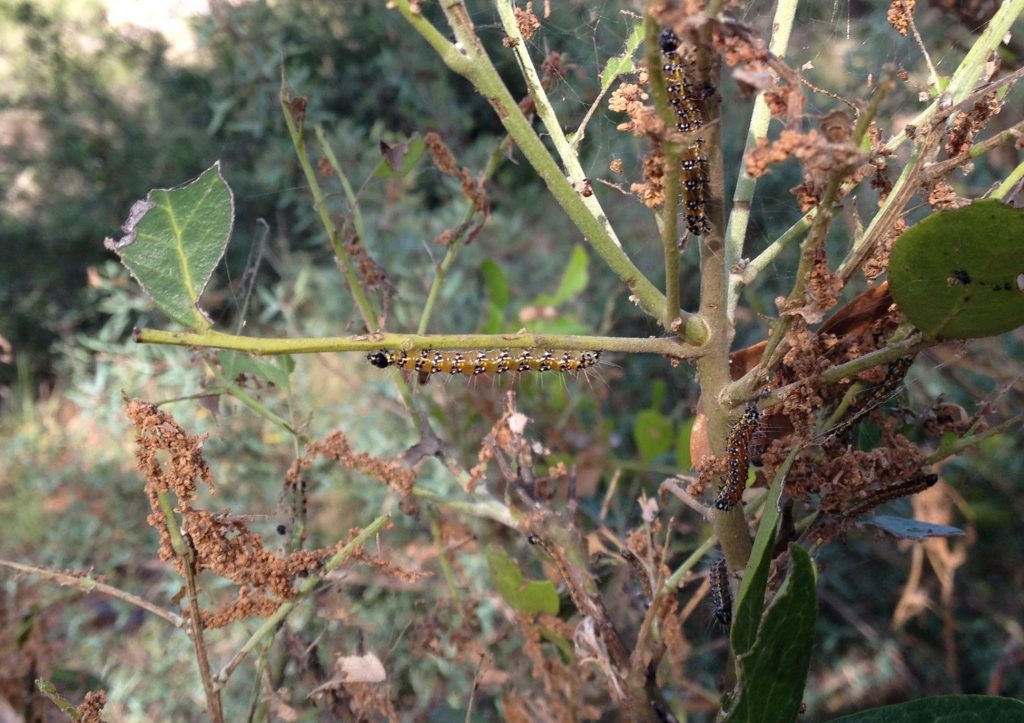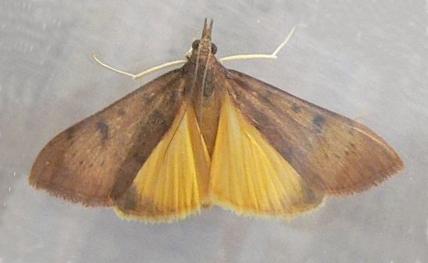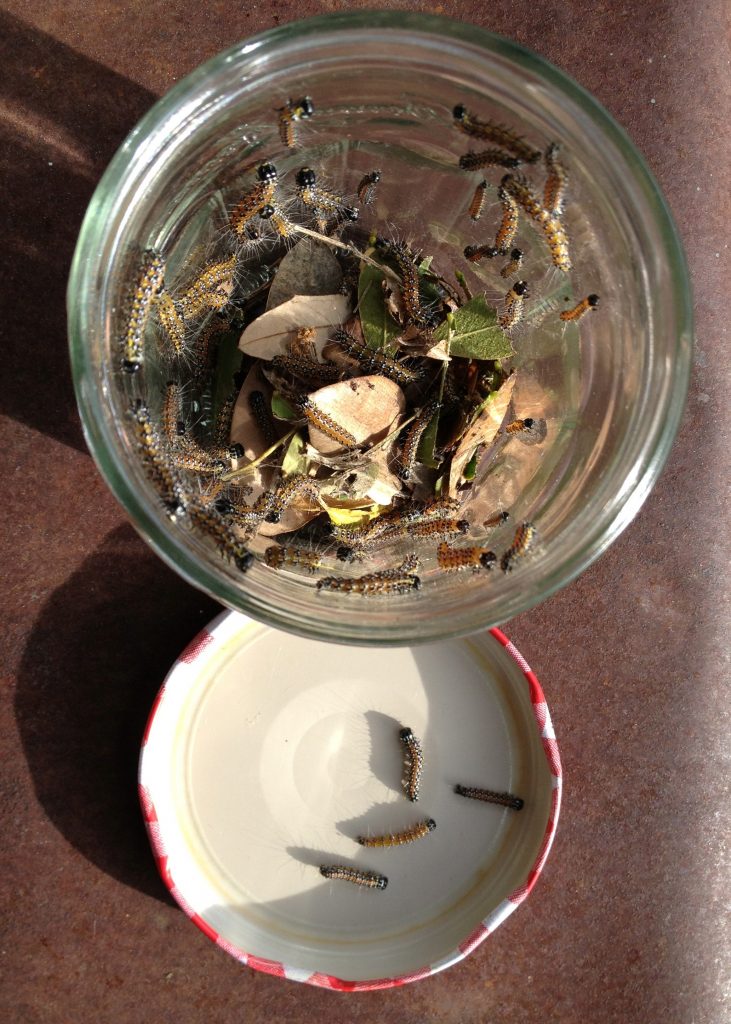A mega hatch of Genista larvae on transplanted Texas Mountain Laurels along the Llano River created an uncomfortable “caterpillar quandary” for me this weekend.

Not cool. Hundreds–no, thousands–of these Genista moth larvae, devoured our Mountain Laurels. Photo by Monika Maeckle
It was an odd day, digging up wild parsley in search of chubby, Eastern Swallowtail caterpillars for fostering and fun at home, followed by hours of trying to figure out a humane and responsible way to kill hundreds–no, thousands–of unwelcome critters decimating several precious Mountain Laurels.
The culprit: the Genista Broom moth caterpillar, Uresiphita reversalis. Sometimes called the Sophora worm, these moth larvae relish the toxic leaves of our native Texas Mountain Laurels, Sophora secundiflora.
We have painstakingly imported several of the gorgeous native evergreens to our stretch of the Llano, digging difficult holes for transplanting them in the Hill Country caliche and watching the slow growers progress over the last 10 years. Mature Mountain Laurels are expensive at nurseries. They serve as a harbinger of spring with their Kool-aid scented purple blooms, which alert us that ground temps have warmed, vegetables can be planted, and summer will be here too soon.
First I tried picking them off by hand. Then I fetched a sheet from the ranch house and shook the bushes, watching as they fell by the dozens to the ground. Finally I got a hose and blew them away with a high pressure jet of well water. Those handpicked and retrieved from the sheet went into a jar that was placed in the freezer for a relatively painless death.

Texas Mountain Laurel, always a harbinger of spring in the Hill County. Blooms form on second year growth. Photo via Ladybird Johnson Wildflower Ctr.
I felt bad. But my Mountain Laurels were decimated. Genista larvae favor new growth and eat the buds and terminals of the Mountain Laurel first. And that’s where the purple flowers form in the spring. Interestingly, I had never noticed the abundant caterpillars in 20 years in Central and South Texas.
“They’re always around,” said Elizabeth “Wizzy” Brown, an integrated pest management specialist for Texas Agrilife Extension Service in Austin, dismissing my theory that something special was going on. I read somewhere that Genistas are poisonous to birds, and speculated that perhaps that’s why they were left seemingly untouched by avian species. Brown dismissed that.
She recommended BT- bacillus thuringeisis, the organic biological pesticide and all- around caterpillar killer. When I let her know I garden for butterflies and moths–just not THIS moth–she suggested getting out the vacuum cleaner to suck them off the tree. Wish I had thought of that.
Entomologist Mark Muegge, a Texas Agrilife butterfly expert out of Ft. Stockton, felt the pain of my “squish remorse.”
“I understand….I’m kinda the same way,” he said. “Sometimes you have to use tough love.”
“They’re not a particularly attractive moth or caterpillar,” sniffed Mike Quinn, an Austin entomologist and founder of the useful Texasento.net website. “There’s no aesthetic reason to not squish them. They’re a pest.”
Brown and Muegge both proposed that the Genista Broom moth’s purpose in the universe is to supply fodder for the food web.
Lizards eat them, the brilliant tachinid fly uses the Genista as a host, laying its eggs on the caterpillars, eating them from the inside out, and wasps also consume the Genista as food. “They fit into the food web,” said Brown.
“Everything has its purpose,” said Muegge. “What they’re good for is hard to say.”
According to Muegge, my reaction to the onslaught of caterpillars may have been extreme, an embarrassing admission for a butterfly evangelist.
“I have never seen a tree or shrub die from being defoliated,” he said. “They’ll stress, but they’ll come back.”
And, fortunately or not, so will those caterpillars.
More posts like this:
- Black Witch Moth: Common, Bat-like and Harmless
- Tomato Hornworm: Loathed by Gardeners, but Morphs into the Magnificent Sphinx Moth
- How do Caterpillars Move? They go with their Gut
- A Year in the Life of a Mostly Native Urban Butterfly Garden
Like what you’re reading? Don’t miss a single post from the Texas Butterfly Ranch. Sign up for email delivery in the right navigation bar on this page, like us on Facebook, or follow us on Twitter, @butterfly beat.



Very informative and educational. Balanced and professional.
Good on TBR !
Thank you.
Thanks for chiming in!
I prefer organic and am attacking this critter w/as many guns as I can round up. The mtn laurel is too expensive to let them take over my world. Thank you for the helpful information…place on food chain, etc. tmorrow, it’s man vs worm one more time!
I feel your pain! Think of your measures as keeping a balance in your garden. Probably, for more reasons than one, conditions were so favorable that you had an outbreak of the moth, but not of it’s natural biological controls. You need to step in to return balance to your garden.
We all favor certain species – some because their habitat in the wild is decreasing. Natural balance is not practical in a small cultivated garden designed to provide habitat to make up for a lack of balance elsewhere. I hope this helps with your dilemma, but your article was interesting and informative. Personally, I absolutely will NOT put up with blister beetles after a horrible childhood experience!
Good luck with your efforts!
Jackie Goetz
Thanks, Jackie.
I have dealt with these for the last couple of years. They totally defoliate the Baptisias. I do think they have killed a couple of the plants as they didn’t come back this year. If there were just a few of them, it wouldn’t be so bad. Be prepared for a second onslaught, as that’s been my experience. In fact, last year, I battled them from spring into fall.
Yikes, Sandra, I hope my Mountain Laurels survive the Genistas’ punishment.
Interesting story…lots of people feel the same way about the tomato hornworm. I didn’t have to worry about them because my German Shepherd thought they were a delicacy and carefully picked them off the tomato plants with her teeth and ate them. Caterpillars are nature’s pruners, but the Genista caterpillars went a little too far. Think it was because there wasn’t enough of the mountain laurel to dilute the large numbers of caterpillars?
Ha, Ann! You have your own organic pesticide. I LOVE tomato and tobacco hornworms–adorable caterpillars and beautiful moths.
Monika, did you dig up wild parsley on the Llano because there isn’t any around here? I’ve been keeping my eyes open for it, but haven’t found any. Same with the Aristolochia erecta for pipevines, although I did see some of that at Guadalupe St. Pk.
Hi Canny,
I just thought it was cool, and I want to try and get it going in my Mom’s new yard, where there’s dappled light. Also, found three Swallowtail caterpillars on it and for the sake of convenience, dug it up to bring them home, since I didn’t have any other host plant.
Stay tuned for a post on raising Swallowtails at home, coming soon. Thanks for writing. — MM
This caterpillar completely defoliated our beautiful Mountain Laurel tree in our backyard last Spring. The tree still has not recovered. I read that they were not harmful for the tree so I left them on there. I’m wishing now that I would have removed them.
hi, do you know if the worms will spread on to fruitless mulberry, live oak or elm trees?
Monika, I understand how you feel. Being from west of San Antonio, I love Mountain Laurel in a “special” way. I have tomatoes this year and am hoping for caterpillars. I’d rather have a moth than tomatoes! Also, I think something is eating our Monarch eggs? We have recently found a yellow with black spots insect which looks like a giant Ladybug. I keep waiting for baby caterpillars but have almost NONE. There were thousands of eggs, seven on one leaf! Can you help me with this puzzle? Thanks, dj
Hi D.J.,
The bug is probably a milkweed beetle or milkweed bug. It’s amazing that most of the insects that gravitate to milkweed are orange and black. Ask our friend Google, and get some pics to see which it is.
As for your eggs, the milkweed bugs, wasps, ants, and others are eating your eggs. That’s why I like to bring them inside. Just tear off the leaf and then bring them in. See the posts written in the past few weeks about How to Raise Monarch Butterflies at Home. Let us know how it goes, and good luck!
MM
another option for webworm control is to remain friendly to wasps and their nests. then, tear open the webbing of the webworms to let their natural predators, the wasps, in!
sometimes, i have even seen the wasps harvest the caterpillars shortly after the hole was torn. one more tip, i’ve used a broom or rake handle to tear open the webs that are difficult to reach.
Thank you for this information. I live in the coastal desert of Baja California Sur, Mexico and have been nurturing my Mtn. Laurel for several years and it’s my favorite plant. There is nothing else as beautiful in this desert landscape. After construction of our house last year, we added a courtyard wall which blocks the wind on the Mtn Laurel and it has doubled in size and is gorgeous. Seemingly overnight the Genista caterpillars appeared and we spent yesterday trimming the damaged area and trying to eliminate the bugs. Thanks to your blog, I will remain vigilant.
I don’t buy the ‘harmless’ idea, either. It happens so fast, and if I don’t catch it immediately they’ll eat all the new foliage and then continue on to the previous years’ growth! All that growth destroyed… And the branches die too (which is actually kind of strange)…
But if I catch the infestation very early, and kill as many as I can sometimes I can limit the damage. But they’ll show up again over the spring and summer any time the trees try to put on new growth so I have to keep a lookout.
I planted my trees 5 or 6 years ago and have fought the worms every year. Just a few minutes ago I saw the first flowers I’ve ever had on these trees! I was excited so I went to look, and the flowers were being eaten by tiny new worms. Spent the past hour squashing as many as I could. Unfortunately they burrow into the flowers so to kill them you sometimes have to smash the flowers too.
I’m completely against toxic chemicals, and for the most part let things be. But in this case, my choice is worms or mountain laurels… If they just ate a little I wouldn’t care, but they don’t stop.
I live in Az, my MTN Laurel just finished blooming, new growth started, as did worms. I trimmed infected areas, and sprayed with heavy soap and water. Will that help deter? Someone told me to add a cooking oil to my mixture.
My neighbor has a Tx MTN Laurel twice the size of mine with no issue?
I just got out my Dyson and spent about 30 minutes sucking the worms off my Texas Mountain Laurel. I check my plant nearly everyday, thankfully I saw the infestation before they devoured more than the top 6 to 8 inches of each limb! My husband cleaned out the vacuum cleaner. I think the after work neighborhood traffic thought I was “mad” out there vacuuming my bushes! It worked very well. I let the hose suck the leaves and the old and chewed up ones were stripped from the small limbs – the new and unharmed ones stayed intact. Organic does not mean no electricity!
I had a nice crop of bluebonnets this year for several years in a row now. Yesterday I noticed the genista caterpillar all over the spent blooms, seed pods and really the whole plant. Will this affect next years crop at all? will they actually eat the seeds too?
@laurie, that’s why I’m here too. We had these lovely volunteer bluebonnets this year and I want them back next year! Also I have four big mountain laurels. Soooooo… guess I’m getting out the hose and setting the nozzle to “jet.”
I have the same problem here in my front yard in Los Angeles county. These caterpillars were devouring my TX MT laurels. I’m trying to do organic and made my own spray with neem oil, organic Sal duds and water. I plucked the caterpillars that I could and sprayed the tree down. It worked wonders.
Patricia. I saw your comment regarding killing the caterpillars in your yard. My husband and I live in the high desert and are having a really tough time with these caterpillars. They ate (and killed) a golden chain tree and have moved on to our Texas Broom. We would like to make the spray you mentioned but don’t know what Sol duds are or how to mix the solution. Currently we are picking them off by hand (which blessedly in winter is only a few each week, but was 20 or so a day last summer). Please share any insight you have on ridding us of this unwanted garden visitor.
Sorry, that was a typo. The soap I use is called Sal Suds. I bought it on Amazon. It’s an organic soap. I looked up the ratios on the internet. It’s a combination of water, soap and need oil. I have to be deligent about using it because the moths come back every year.
When do caterpillars usually attack? I grow few plants in Barbados, 3 yrs, and did not notice anything..we may not have this moth on the island…Slow growing in 2 first years and third year much faster. No caterpillars noticed.
I live in central Indiana, and just found these this morning on my baptisia. They have stripped several stems. I picked them off and put them in the soapy water (with the Japanese beetles!) and sprayed the plant with Thuracide. I Iike the idea of putting them in a jar and then putting them in the freezer for a less horrific death. I try to be live and let live, but am not willing to sacrifice my baptisia!
So, that’s what those things are. I’m in San Antonio and they attacked mine but there were not too many of them. Mountain laurels pop up all over the place in my yard so I have to hack a few down now and then. I’ve been growing one as a side plant for a mini-garden and have pruned and propped it up for years and its now at a decent height – about 15 feet. I’ll remember to hose it down next spring. Thanks.
Squish remorse!! Exactly. Is it silly that I pick them off by hand (hundreds a day year after year) and throw them far away, hoping they will eat something else?? Do they make it back to the Mountain Laurel I wonder? I pay my children per caterpillar if they help me. I wondered why my chickens wouldn’t eat them… Now I know! Great article thank you.
I have two TMLs. One in the front and one in the back. Only the one in the back gets these little pests (thankfully). I live in AZ so we also have scorpions. When I start to see my leaves being eaten or webs, I pick off the worms and place them in our “scorpion jar” and leave it in the sun. Dead in short order.